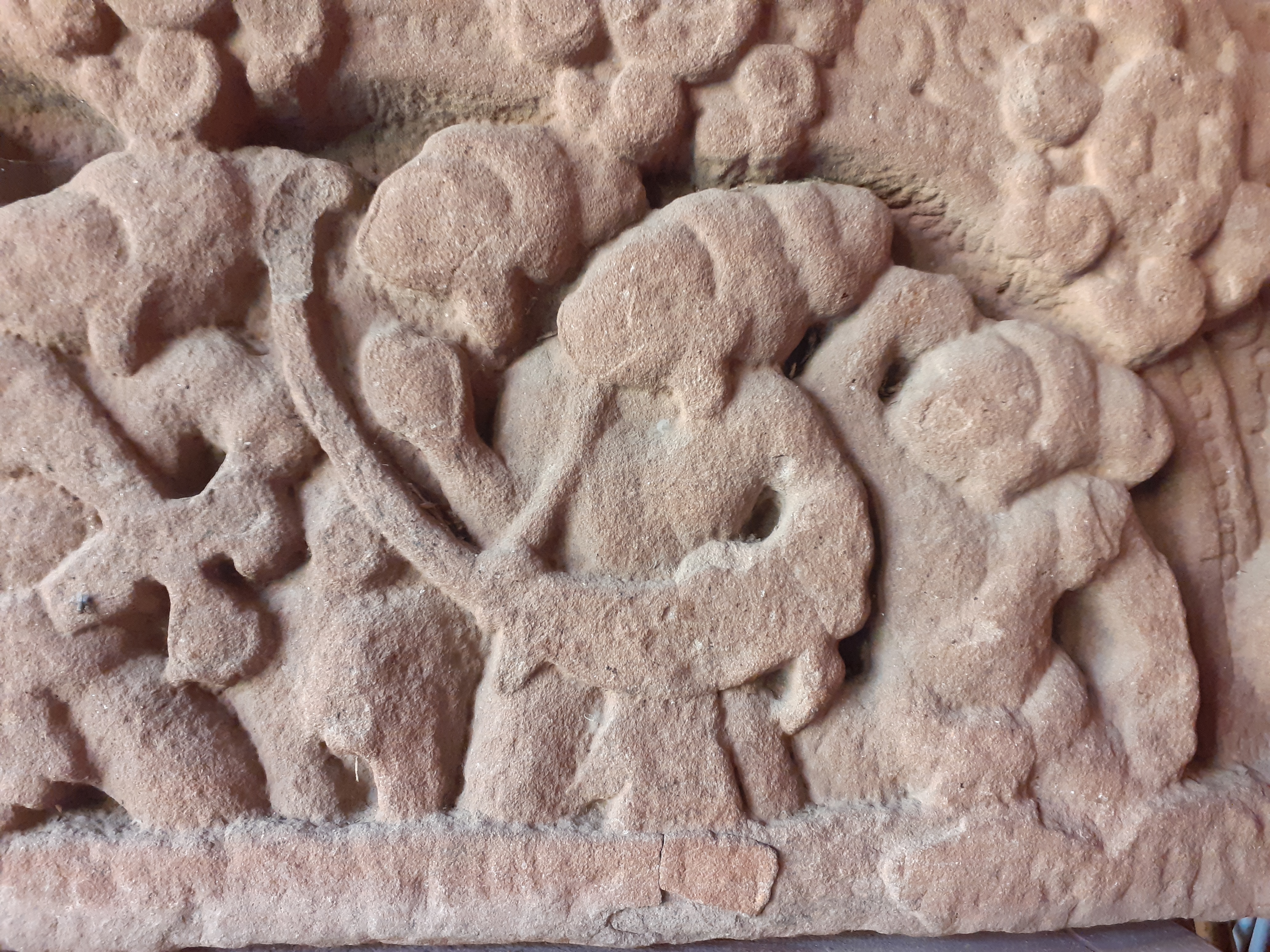Pin (harp) on:
[Wikipedia]
[Google]
[Amazon]
The pin ( km, ពិណ, ) is a Cambodian harp, one of the most historically important instruments in Cambodian music. The instrument went extinct 1500s, and is now being restored in modern times. Its historical importance is emphasized by the very name for Cambodian classical music, ''
 The ''pin'' may have been introduced to Cambodia since
The ''pin'' may have been introduced to Cambodia since
 Ethnomusicologist Patrick Kersalé, who has worked in Asia for more than 20 years, studied images left over from the past, "tracing out the shape of the harp." He looked for clues to understand how the harps were used and made. He also looked at similar instruments in the region, such as the Burmese
Ethnomusicologist Patrick Kersalé, who has worked in Asia for more than 20 years, studied images left over from the past, "tracing out the shape of the harp." He looked for clues to understand how the harps were used and made. He also looked at similar instruments in the region, such as the Burmese
Photo of Cambodian pin (harps) being incorporated into a modern theater showing traditional dance and music.
Video showing modern performance of "Apsara dance" music, with Pin harp, samphor drum (on table) and skor thom drums (on floor).Video, showing a pin being played solo. Interspersed with video of Cambodian countryside, with harp music forming soundtrack.
Mysteries of the Khmer harp
9 April 2016. tuk-tuk.tv {{Cambodian musical instruments Cambodian musical instruments Arched harps Reconstructed musical instruments
pinpeat
The ''Pinpeat'' ( km, ពិណពាទ្យ, ) is the largest Khmer traditional musical ensemble. It has performed the ceremonial music of the royal courts and temples of Cambodia since ancient times. The orchestra consists of approximately ni ...
'' (Khmer: ពិណពាទ្យ). After the pin was no longer being used, Cambodians continued to use the instrument's name for classical music into the present era. When the pin was no longer being used, the tonal range of other instruments was expanded, possibly to compensate. Burmese ''saung gauk
The ''saung'' ( Burmese: စောင်း, MLCTS caung: ; also known as the ''saung-gauk'' ( စောင်းကောက်), Burmese harp, Burma harp, or Myanmar harp), is an arched harp used in traditional Burmese music. The saung is ...
'' and '' roneats'' had more keys for the chromatic scale and the number of gongs in the ''kong von thom
The kong von thom or ''kong thom'' ( km, គងធំ) plays a melodic line in the Cambodian '' pinpeat'' ensemble almost identical to that of the roneat thung (large xylophone). The ''kong thom'' dwells more steadily on the pulse without pullin ...
'' and ''kong toch
The ''kong vong toch'' ( km, គងវង់តូច or kong touch km, គងតូច) is a number of gongs that are attached to a circle-shaped rack, closely resembling its larger relative, the kong thom. Both instruments belong to the percus ...
'' "more than doubled in number since the musician depicted on the Angkorian carvings."
Etymology
The word ''pin'' (ពិណ) derived from theSanskrit
Sanskrit (; attributively , ; nominally , , ) is a classical language belonging to the Indo-Aryan branch of the Indo-European languages. It arose in South Asia after its predecessor languages had diffused there from the northwest in the late ...
word '' veena/ vina'' (वीणा). This musical instrument gave the name to Cambodian traditional musical ensemble known as ''pinpeat
The ''Pinpeat'' ( km, ពិណពាទ្យ, ) is the largest Khmer traditional musical ensemble. It has performed the ceremonial music of the royal courts and temples of Cambodia since ancient times. The orchestra consists of approximately ni ...
''.
History
 The ''pin'' may have been introduced to Cambodia since
The ''pin'' may have been introduced to Cambodia since Funan
Funan (; km, ហ៊្វូណន, ; vi, Phù Nam, Chữ Hán: ) was the name given by Chinese cartographers, geographers and writers to an ancient Indianized state—or, rather a loose network of states ''(Mandala)''—located in mainla ...
period; however, the earliest surviving depiction of the pin in Cambodia is dated to the 7th century on the temple at Sambor Prey Kuk, the capital of Chenla
Chenla or Zhenla (; km, ចេនឡា, ; vi, Chân Lạp) is the Chinese designation for the successor polity of the kingdom of Funan preceding the Khmer Empire that existed from around the late sixth to the early ninth century in Indoc ...
. The instrument appeared in Hindu religious art in Khmer temples dating back between the 7th and 13th centuries A.D. The instrument was recorded in a bas-relief at Bayon
The Bayon ( km, ប្រាសាទបាយ័ន, ) is a richly decorated Khmer temple related to Buddhism at Angkor in Cambodia. Built in the late 12th or early 13th century as the state temple of the King Jayavarman VII ( km, ព្រ� ...
, Cambodia, a Buddhist temple built in the 12th to 13th century A.D. During the Angkor
Angkor ( km, អង្គរ , 'Capital city'), also known as Yasodharapura ( km, យសោធរបុរៈ; sa, यशोधरपुर),Headly, Robert K.; Chhor, Kylin; Lim, Lam Kheng; Kheang, Lim Hak; Chun, Chen. 1977. ''Cambodian-Engl ...
era from the 9th to the 14th centuries A.D., it was still being played in the royal Khmer ensemble.
There are multiple theories for the disappearance of the instrument. "One idea is that the instrument disappeared because of the development of the melodic percussion orchestra." Another theory is that the instrument was lost in 1431 during the war that demolished the Angkor civilization. One more theory is that it was associated with Hindu religion and the instrument was left behind as the country became Buddhist.
Recreation
 Ethnomusicologist Patrick Kersalé, who has worked in Asia for more than 20 years, studied images left over from the past, "tracing out the shape of the harp." He looked for clues to understand how the harps were used and made. He also looked at similar instruments in the region, such as the Burmese
Ethnomusicologist Patrick Kersalé, who has worked in Asia for more than 20 years, studied images left over from the past, "tracing out the shape of the harp." He looked for clues to understand how the harps were used and made. He also looked at similar instruments in the region, such as the Burmese saung gauk
The ''saung'' ( Burmese: စောင်း, MLCTS caung: ; also known as the ''saung-gauk'' ( စောင်းကောက်), Burmese harp, Burma harp, or Myanmar harp), is an arched harp used in traditional Burmese music. The saung is ...
and harps of the Kareni people. Kersalé asked Keo Sonan Kavei (a craftsman) to help him build the harp. To help the instrument become part of active culture again, Him Sophy began to compose for it.
References
External links
Photo of Cambodian pin (harps) being incorporated into a modern theater showing traditional dance and music.
Video showing modern performance of "Apsara dance" music, with Pin harp, samphor drum (on table) and skor thom drums (on floor).
See also
*Saung
The ''saung'' ( Burmese: စောင်း, MLCTS caung: ; also known as the ''saung-gauk'' ( စောင်းကောက်), Burmese harp, Burma harp, or Myanmar harp), is an arched harp used in traditional Burmese music. The saung is re ...
, the Burmese arched harp
External links
Mysteries of the Khmer harp
9 April 2016. tuk-tuk.tv {{Cambodian musical instruments Cambodian musical instruments Arched harps Reconstructed musical instruments